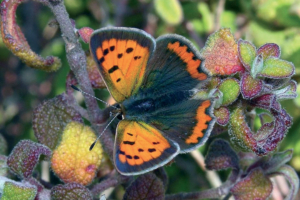BUTTERFLY GARDEN
Favonius quercus
Linnaeus, 1758 – (Blue Oak Hairstreak)
The Blue Oak Hairstreak is a relatively small species, fairly common though not very easy to spot due to its habits of flying in the upper part of the tree canopy. These are univoltine* species, and the first specimens fly at the end of summer, when they usually flutter over the fig trees or brambles. Both sexes show a patch of splendid intense blue on the upper part of the forewings, very extensive in the male, while reduced to a fairly narrow band in the females. The caterpillars feed on the leaves of various species of the genus Quercus.
Lycaena phlaeas
Linnaeus, 1761 – (Little Copper Butterfly)
It is a small and very lively butterfly that is distributed practically throughout the northern hemisphere. Present on almost all the Mediterranean islands and the Tuscan archipelago, it can be observed on all the islands except Montecristo, Gorgona and Giannutri. The two sexes are practically indistinguishable and both have a splendid bronze-red tint on the upper part of the wings, which can however only be admired when the butterfly is perched, since the speed of its flight prevents it from appreciating its tint. It is one of the first species to emerge and it is not uncommon to see it flying from the first half of February to the last days of October. During this long period, the bronze copper butterfly manages to complete as many as 3 generations and hibernate in the pupal stage. The caterpillar eats mainly sorrel (Rumex spp.).
Polyommatus icarus
Rottemburg, 1775 – (Common Blue; Icarus)
The Common Blue is perhaps the most common butterfly in the entire Mediterranean. It can be found from sea level to fairly high elevations. It is a very small and showy butterfly, especially the male that shows a beautiful metallic blue color on the upper part of both wings, while the female is much more anonymous and has a brownish color. Despite having a fairly fast and frenetic flight, it makes numerous stops, particularly on the heads of the composites, where it lingers to feed and mate. In the Tuscan Archipelago it can be seen on Elba, Giglio, Pianosa and Capraia from the first days of spring to autumn. This is a multivoltine* species and can complete up to 3 generations in the archipelago. The larva feeds mainly on Leguminosae (Trifolium spp., Medicago spp. etc.) and deserves special attention as far as its biology is concerned, since it is a case of “facultative myrmecophilia”, i.e. the larva can be protected by ants and are defended that live on the host plant, which they sometimes even bring into their anthill, where they feed it until it hatches into a butterfly.





